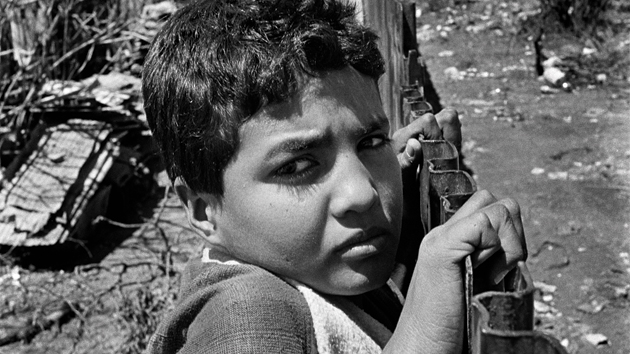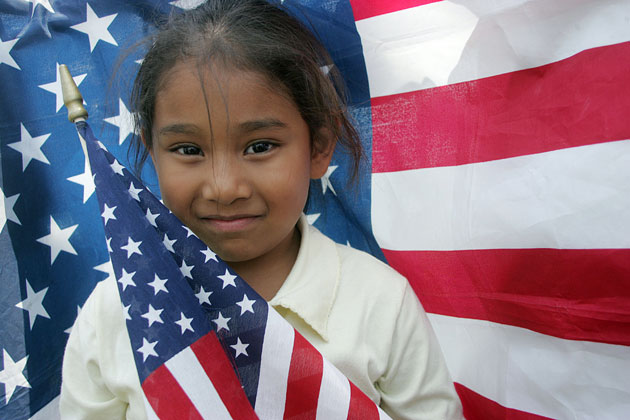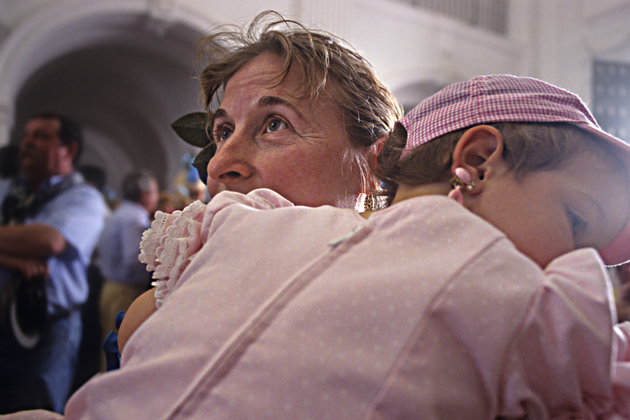
Joseph Rodriguez
In a doorless desert safe house in northwestern Mexico, the drug traffickers sized up the boy—17 years old, 1,700 miles from home, gay, alone—and asked if he was too scared to strap on a load of marijuana and walk across the border into Arizona.
The kid—I’ll call him Adrián—paused to consider his options. He didn’t have any. Okay, he told them. He’d do it.
He’d grown up mostly on the streets in Guatemala City, his abusive father a crack addict and his mother everywhere but around, leaving him with a thin, green-eyed prostitute friend who would sometimes have sex with johns right there next to him. He’d seen robberies, stabbings, shootings; he’d never once set foot in a classroom. Eventually he started making a little money selling clothes and makeup in the city’s colonial district. It wasn’t much, but even so the Barrio 18 street gang took notice and started asking for a cut. When Adrián didn’t budge, they pockmarked his tiny stall with bullets. It was time to leave.
Just like that, Adrián became part of an explosion of child migrants traveling alone to sneak into the United States, a group government officials and advocates have begun referring to, with alarm, as “the surge.” The number of undocumented children—mostly teens, but some as young as five—apprehended crossing the border without parents or guardians has more than doubled in the past two years, while the number of adults caught at the border increased just 18 percent. On June 2, President Obama described it as an “urgent humanitarian situation,” asking Congress for an additional $1.4 billion to deal with the influx and creating a multiagency taskforce, led by the Federal Emergency Management Agency, to coordinate the federal response.
The surge was already in full swing by the time Adrián started on his path north, in December 2012. He took a bus to the Mexico-Guatemala border, crossed the Suchiate River by inner tube into the state of Chiapas, and stole a bike to pedal to the city of Tapachula. He walked 150 miles north, making sure to skirt La Arrocera, a broad swath of scrubland known for migrant kidnappings and assaults. He slept on the doorstep of a church after finding the migrant shelter burned to the ground.
Then, in the town of Arriaga, he hopped aboard La Bestia, the infamous freight train that many migrants ride to the US border despite the often-repeated horror stories: the surging wheels that slice through people who slip trying to jump on moving boxcars, or fall off while sleeping; the thieves who go car to car with machetes or .38s; the night raids from Mexican law enforcement as well as kidnappers sent by Los Zetas.
Adrián rode La Bestia to Guadalajara, where he spent a sleepless Christmas night on a sidewalk. He got back on and rode for days until reaching Monterrey, where he was forced off the train when someone attacked him with a machete because he was gay. He fled barefoot on the trackside gravel and walked an hour to a village, where, his feet bleeding, he pleaded for a pair of shoes.
He begged for money. He sold newspapers. He even sold his body for $50. He headed north to the border at Nuevo Laredo; when he couldn’t get across, he moved backward, 450 miles south to San Luis Potosí, 200 miles west to Guadalajara once more, before heading another 1,000 miles north to the Sonora Desert, finally ending up in that decrepit safe house near the border.
So when it was time to make his final push across the line, and the traffickers asked if he was too scared to continue, Adrián said no. Fear, after all, was driving him forward.
When the Border Patrol caught Adrián a week later in the Arizona desert—he’d ditched the pot at a drop point along the way—he became one of the 38,833 unaccompanied minors apprehended by the Border Patrol in fiscal year 2013. That was a 59 percent jump from the year before, and a 142 percent increase from fiscal 2011; no one knows how many more kids avoided Border Patrol detection, or never got that far. This year, officials have told advocates they anticipate the numbers to double again, to as many as 74,000 unaccompanied children.* That’s equivalent to every single student in Dallas’ 81 public middle and high schools getting up and walking across the border in a single year.

Although some have traveled from as far away as Sri Lanka and Tanzania, the bulk are minors from Mexico and from Central America’s so-called Northern Triangle—Guatemala, Honduras, and El Salvador, which together account for 74 percent of the surge. Long plagued by instability and unrest, these countries have grown especially dangerous in recent years: Honduras imploded following a military coup in 2009 and now has the world’s highest murder rate. El Salvador has the second-highest, despite the 2012 gang truce between Mara Salvatrucha and Barrio 18. Guatemala, new territory for the Zetas cartel, has the fifth-highest murder rate; meanwhile, the cost of tortillas has doubled as corn prices have skyrocketed due to increased American ethanol production (Guatemala imports half of its corn) and the conversion of farmland to sugarcane and oil palm for biofuel.
Many of the kids are coming to help a family in crushing poverty. Some are trying to join a parent who left years ago, before the recession and increased border enforcement slowed down adult immigration. Still others are leaving because of violence from family members and gangs. According to a report from the United Nations High Commissioner for Refugees, 58 percent of the 400 youth the agency interviewed “had suffered, been threatened, or feared serious harm” that might merit international protection. “This is becoming less like an immigration issue and much more like a refugee issue,” says Wendy Young, executive director of Kids in Need of Defense (KIND), a DC-based nonprofit that helps unaccompanied immigrant kids find pro bono legal services. “Because this really is a forced migration. This is not kids choosing voluntarily to leave.”
US authorities have struggled with how to handle the tens of thousands of kids who end up caught by the Border Patrol. Those coming from Mexico are taken straight back across. The rest are referred to the Department of Health and Human Services’ Office of Refugee Resettlement (rather than being put in immigration detention with adults) and placed in temporary shelters while their deportation proceedings get under way.
Journalists aren’t allowed into these shelters “for safety reasons,” an ORR spokeswoman told me—due to concerns about trafficking victims, the agency goes to great lengths to conceal the exact locations of its facilities. It also forbids the groups that run them, including Catholic Charities and Southwest Key, from commenting on the issue. It took me a Freedom of Information Act request to obtain basic statistics, like the number of facilities (80) and the average time kids stay in the shelters (45 days in 2013, down from 72 in 2011).
Susan Terrio, a Georgetown University anthropologist, visited 19 shelters over four years before the government cut off her access. She found an almost hermetically sealed system: “The kids were never left unattended. They went to school inside, they played sports inside, and they only got out for supervised outings in the community or for medical and mental-health appointments.” Maria Woltjen, director of the Young Center for Immigrant Children’s Rights, says that as a result, unaccompanied children are essentially invisible: “Nobody in Chicago knows there are 400 kids detained in our midst. You walk by, and you think it’s just an old nursing home, and it’s actually all these immigrant kids who are detained inside.”
In fiscal 2011, ORR had 53 shelters that housed 6,560 kids. By 2013, there were 80 shelters with nearly 25,000 unaccompanied children. The surge was so unexpected that when it first began, the feds temporarily put hundreds of kids in emergency dormitories at Lackland Air Force Base in San Antonio. According to a report from the Women’s Refugee Commission, “the facility looked and felt like an emergency hurricane shelter.” As recently as May, shelters in South Texas were so crowded that ORR was sending hundreds of kids to Lackland, which has room for 1,000.
The majority of shelters are in border states, often hours from big cities, which means it’s even harder for kids to find legal representation and stave off being sent back to the dangerous situations they fled. When KIND first started its pro bono work, Young says, it estimated that three-quarters of all unaccompanied kids received no legal representation. KIND was able to get that number to 50 percent, she says, but given the influx, “I fear now that we’ve slipped backwards quite dramatically.”
Nonprofits like KIND say the government should appoint lawyers for unaccompanied children, noting that many actually qualify for legal status via asylum, special immigrant juvenile status (for abandoned, abused, or neglected kids), or visas set aside for victims of crimes or trafficking. But proposals in that vein, by lawmakers including Sen. Mary Landrieu (D-La.), have gone nowhere.
In mid-December, I visited the immigration court in Harlingen, Texas, a squat beige building that sits in the shadow of crisscrossing highway overpasses a few miles from the Rio Grande. The area is home to the nation’s highest concentration of children in immigrant shelters, and the Harlingen court is where those kids appear before an immigration judge. Inside Judge Howard Achtsam’s courtroom, the Homeland Security attorney sat at a table piled high with files. One of the four children who appeared before Achtsam that day represented himself; another appeared with his attorney from ProBAR, the American Bar Association’s pro bono legal project in the Lower Rio Grande Valley. Attorneys were representing two clients who weren’t there, thanks in part to ORR’s new emphasis on quickly reunifying kids with family members, often in faraway cities, as they await deportation proceedings. (Some 90 percent of children placed in shelters end up with US-based family.) While that is generally a good thing, said ProBAR director Kimi Jackson—certainly better than the months-long shelter stays that were common as recently as last year—it means that attorneys are less likely to be able to meet and interview kids. It also means that the government has less time to vet the people claiming to be the kids’ relatives.
What happens to the children, I asked Jackson, once they go off ProBAR’s radar? “I don’t have data,” she told me, shaking her head. “I don’t know that anyone does.”
Toting a walkie-talkie and chatting as she goes, Julie Kessler parts a sea of teenagers with gelled hairdos, cheap cologne, and skinny jeans. She’s got an eye out for colors—red for Norteños, blue for Sureños, both banned—and for making out. “There’s too much kissing for my taste,” she tells me with a smirk, right before she pulls aside a boy for his red T-shirt. She hands him a gray one, emblazoned with the San Francisco County Sheriff’s Department logo, that hangs loose on his skinny frame. “Off you go!” she says.
Kessler is the principal of San Francisco International High School, a public school for newcomers in the city’s Mission District: 100 percent of its students are recent immigrants and English-language learners. Spanish- and Chinese-speaking students dominate, though 14 other languages are represented. “Most schools are like, ‘I don’t know what to do with this population! Their needs are so different from the rest of my class!'” Kessler says. Here, “they are the rest of the class.” She estimates that about a fifth of her students immigrated alone.
This is where I first met Adrián. Back when he was apprehended in Tucson, he sat for a spell in a heavily air-conditioned Border Patrol holding cell known as a hielera (“ice box”). Then he stayed at a nearby ORR shelter for a few months before they asked him where he wanted to go next. With no family in the States, he chose San Francisco, and that’s how he ended up at a youth shelter in the city. His social worker later connected him to a pro bono attorney. (He told me he won legal status earlier this year, though he was unsure exactly how.)
Integrating a student like Adrián—with zero schooling and years of trauma—is no small task for Kessler and her staff, nor is it an uncommon one. “The vast majority of our kids are suffering from PTSD of one form or another,” she says. “For some of them, that’s about, ‘I’m fleeing a civil war.’ But for more of them, it is on a personal level, of ‘I was living on the streets of Honduras, and finally realized that wasn’t going to work.'” And then there are the challenges of the kids’ new American homes, often with relatives who are essentially strangers, in neighborhoods rife with the same problems—gang violence, drugs—they once tried to escape.

In Los Angeles, the school district’s mental-health director, Pia Escudero, reviewed records for students entering a newcomer school there; she found that 94 percent of those given mental-health screenings reported at least three traumatic events, and 65 percent had clinical symptoms “in the range of PTSD and depression.” They experience hyperarousal and hyperalertness, and everyday urban sounds—say, a helicopter passing overhead—can trigger flashbacks.
San Francisco International offers counseling and mental-health services, and to many of the kids, the school is a refuge: Nearly 80 percent said they felt safe at school, 10 percent better than the districtwide numbers. The first time I visited, the school went on lockdown when a student brought a pellet gun to campus. But he wasn’t in a gang, Kessler told me after five San Francisco cops showed up to secure the scene; he was just fronting.
It was here that I met Audelina Aguilar, who at 14 made the journey from Guatemala to the US border by herself, warding off a would-be rapist in Mexico and walking past corpses in southern Texas before making it to the Bay Area, where her brother lived. She cleaned houses full time for two years, then got so sick she had to go to the emergency room, where the nurses asked why she was not in school. Now a legal permanent resident and a senior who’s been accepted to several colleges, she’s also the head of a growing household, caring for two younger brothers who were caught crossing the border and sent to San Francisco while their immigration hearings play out. Aguilar has seven more siblings and her parents back in the western Guatemalan highlands.
And then there’s Adrián, who told me the guys at the shelter stole his stuff and constantly harassed him; Kessler noted that it was a daily battle for him to get to school. One day, as we walked through the near-empty cafeteria, another boy catcalled Adrián, who shot him a sideways glance.
“I’m not here to make friends,” he told me. He was wearing a gray T-shirt, black jeans, and a gauzy scarf full of tie-dyed peace symbols that sort of covered up two large bruises on his neck. He said he was hoping to graduate and move on, maybe go to cosmetology school.
In January, when I emailed Kessler to set up a final interview with Adrián, she told me that the shelter had decided to move him to San Jose. She hasn’t heard from him since.
Two weeks later, my phone rang. “I’m here in San Francisco,” Adrián said. “Do you want to meet now?” I trudged through the February rain to a McDonald’s on Market Street. Adrián was wearing ’80s rocker ripped jeans and kelly-green nail polish and ordering two cheeseburgers and fries. I helped him carry his beat-up bike downstairs, and we settled into a booth to talk.
He decided to leave for San Jose, he told me, to get away from the drama at the shelter. It was boring in the South Bay, and he missed school, even though he found it a bit tedious—but soon he’d be turning 19, and at that point he could live on his own with the government’s blessing.
And the bruises I’d seen on his throat? I mean, I had to ask. “Niño,” he said, his voice caramel sweet and condescending, “those weren’t bruises. They were hickeys.”
We swapped contact info one last time, and as I headed back to the office, I remembered something he’d once told me about why he’d left Guatemala. “I wasn’t really looking for the American Dream,” he’d said, readjusting his scarf for the hundredth time. “I just wanted to get far away.”
UPDATE, November 20, 2014 (Ian Gordon): According to US Customs and Border Protection, 68,541 unaccompanied children were apprehended at the border in fiscal 2014. Despite some government funding for legal aid, many of them are still struggling to find lawyers. Meanwhile, President Obama’s executive action does not provide relief from deportation for recent child migrants.
This story was made possible by a fellowship from the French-American Foundation—United States.
















